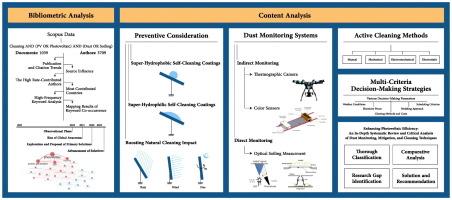提高光伏发电效率:对粉尘监测、缓解和清洁技术的深入系统回顾和批判性分析
IF 11
1区 工程技术
Q1 ENERGY & FUELS
引用次数: 0
摘要
在污染和桌面光伏系统领域的大多数综述研究主要集中在潜在的粉尘缓解和分析方法上。然而,对这一领域的研究趋势进行全面的长期文献计量分析仍然是必要的。本研究的重点是对现有的光伏系统污染缓解文献进行系统和文献计量学分析。讨论了文献中的一般趋势,然后讨论了减缓战略的四大类。综述的文献分为预防措施、粉尘监测系统、主动清洁方法和清洁计划的多准则决策策略。预防措施主要集中在被动技术,以加强除尘,如自清洁涂层。然而,这些策略在很大程度上取决于风、雨强度和湿度等环境因素,这些因素有时会导致胶结或灰尘积累增加等问题。在过去的四十年中,在探索各种主动清洁方法时,这些方法分为四种类型:手动,机械,机电和静电方法。将这些方法与监测系统和动态决策模型相结合对于经济上可行的污染缓解至关重要。讨论了污染监测系统和清洁间隔规划决策的若干研究。本文综述可为今后预防性清洗、光伏系统监测、主动清洗方法和决策策略等方面的研究提供参考。解决已确定的挑战将提高光伏系统的部署和效率,为更可持续的能源解决方案做出贡献。本文章由计算机程序翻译,如有差异,请以英文原文为准。

Enhancing photovoltaic efficiency: An in-depth systematic review and critical analysis of dust monitoring, mitigation, and cleaning techniques
Most review studies in the field of soiling and tablephotovoltaic systems primarily focus on potential methods for dust mitigation and analysis. However, a comprehensive long-term bibliometric analysis of research trends in this field remains necessary. This study focuses on a systematic and bibliometric analysis of existing literature on soiling mitigation in photovoltaic systems. The general trends in the literature are discussed, followed by four main categories of mitigation strategies. The reviewed literature is categorized into preventive measures, dust monitoring systems, active cleaning methods, and multi-criteria decision-making strategies for cleaning schedules. Preventive measures primarily focus on passive techniques for enhancing dust removal, such as self-cleaning coating. However, these strategies significantly depend on environmental factors like wind, rain intensity, and humidity, which can sometimes lead to issues like cementation or increased dust accumulation. In exploring various active cleaning methods over the past four decades, these methods are classified into four types: manual, mechanical, electromechanical, and electrostatic approaches. Integrating these methods with monitoring systems and dynamic decision-making models is crucial for economically feasible soiling mitigation. Several studies on soiling monitoring systems and decision-making for planning cleaning intervals are also discussed. This comprehensive review serves as a reference for future research on preventive cleaning, PV system monitoring, active cleaning methods, and decision-making strategies. Addressing the identified challenges will enhance the deployment and efficiency of PV systems, contributing to more sustainable energy solutions.
求助全文
通过发布文献求助,成功后即可免费获取论文全文。
去求助
来源期刊

Applied Energy
工程技术-工程:化工
CiteScore
21.20
自引率
10.70%
发文量
1830
审稿时长
41 days
期刊介绍:
Applied Energy serves as a platform for sharing innovations, research, development, and demonstrations in energy conversion, conservation, and sustainable energy systems. The journal covers topics such as optimal energy resource use, environmental pollutant mitigation, and energy process analysis. It welcomes original papers, review articles, technical notes, and letters to the editor. Authors are encouraged to submit manuscripts that bridge the gap between research, development, and implementation. The journal addresses a wide spectrum of topics, including fossil and renewable energy technologies, energy economics, and environmental impacts. Applied Energy also explores modeling and forecasting, conservation strategies, and the social and economic implications of energy policies, including climate change mitigation. It is complemented by the open-access journal Advances in Applied Energy.
 求助内容:
求助内容: 应助结果提醒方式:
应助结果提醒方式:


